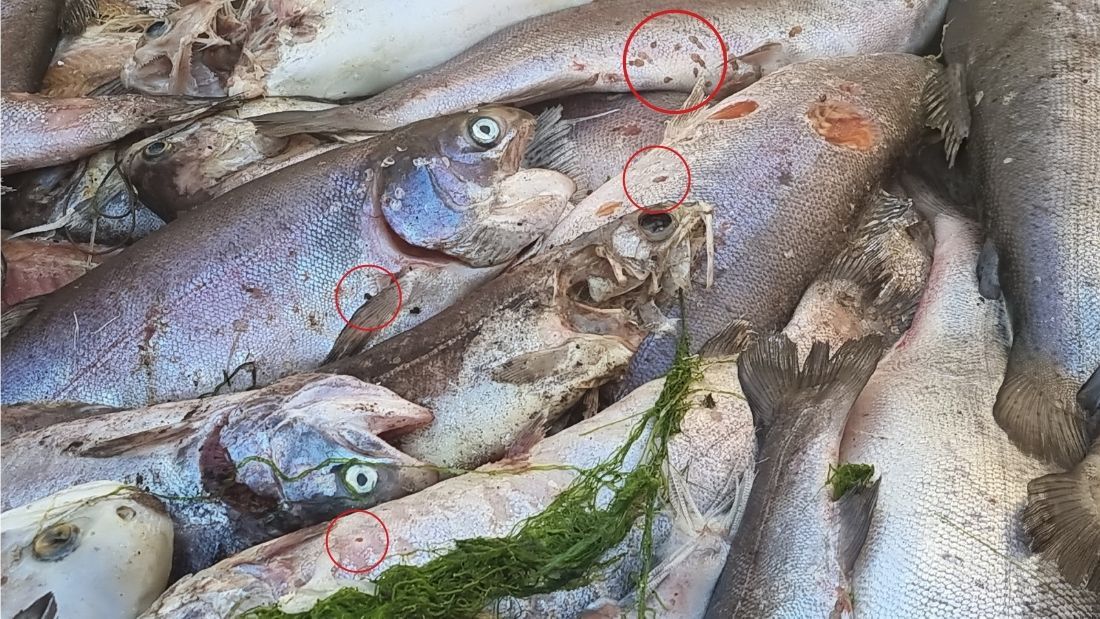Lice-nsed to Kill – what the supermarkets don’t want you to know about farmed fish

- Sea lice are eating fish alive
- 100% of Scottish Atlantic salmon are factory farmed
- Is your salmon infested with lice?
Viva!, the UK’s leading vegan campaigning charity, has launched a new campaign which will make even the most hardened of consumers squirm.
Launching this April, Viva!’s pioneering sea lice awareness campaign will highlight the invasion of parasitic sea lice across the UK’s salmon and trout farms. Using shocking footage taken from their own fish farming investigations, Viva! reveals how intensive fish farms provide the perfect breeding ground for these underwater parasites and the devastating impact they have on both farmed and wild fish.
Could your fish supper be contaminated with sea lice? Read on to find out more.
In the wild, salmon and trout are affected by naturally-occurring parasites known as sea lice. But as anadromous species – a term that describes fish born in fresh water who spend most of their lives in salt water and return to fresh water to spawn – salmonids are well-adapted to cope with the odd passenger, dislodging them during their migration. A lice found on a wild salmon or trout is normally an indicator that they’ve recently returned from the ocean to deposit eggs.
Sadly, in the world of intensive fish farming this is not the case. Thousands of fish are forced to live in confined, filthy sea cages where they’re unable to migrate to fresh water and therefore shed the lice.
High stocking densities on fish farms ultimately increases the occurrence of sea lice, creating a breeding reservoir that produces huge numbers of mobile juvenile sea lice, spoilt for choice in terms of finding a host fish. It’s a catastrophic consequence of the intensive aquaculture system.
Lice infestations cause unnecessary suffering for fish, resulting in severe scale damage, reduced growth rates and a loss of their physical and microbial protective function as the lice graze on their skin, mucus and blood. Ultimately, farmed fish are increasingly susceptible to disease, secondary infection, and premature death.
As if that isn’t bad enough, huge concentrations of sea lice also escape to the local marine environment and impact wild populations. A single salmon farm can increase the sea lice burden on migrating juvenile salmonids by as much as 73 times above normal levels. Clouds of lice will attach themselves to passing salmon and sea trout smolts, whose young fragile skin is not yet adapted to cope with infestations of parasites, and they are literally eaten alive. The lice can also be carried and spread to other wild fish, threatening the survival of entire species.
The aquaculture industry’s solution to this? Harsh chemical treatment or the use of machine-based technologies called hydrolicers and optilicers or thermolicers. These systems work by pumping the fish through a network of fresh water jets (hydrolicers) or passing them through heated water baths (optilicers and thermolicers) fitted to a boat or barge. Both treatments take advantage of the low tolerance sea lice have for fresh water or sudden changes in temperature. Once dislodged they are collected and destroyed. This practice has been reported to create high levels of anxiety, pain and death to fish.
According to the Scottish government, an average of 112,000 fish die every year in these devices and recent scientific research has also found that salmon exposed to water temperatures above 28 degrees Celsius behaved as if they were in pain – swimming faster, crashing into tank walls and shaking their heads.
Despite multiple treatments to rid fish of lice, the problem is so widespread that it is near impossible to guarantee fish sold for human consumption will be lice-free. Disturbingly, fish for sale on supermarket counters have even been found with lice still attached. Not an appetising thought! Aquaculture is the world’s fastest growing food production sector and more than half the fish on supermarket shelves come from aquatic factory farms. In the UK, 100 per cent of Scottish Atlantic salmon are reared on intensive fish farms. Viva!’s new campaign warns fish-eaters that they may be getting more than they bargained for when buying fish, and encourages them to try vegan.
Viva! Campaigner Alice Short says: ‘We want to show the British public how easy it is to stop eating fish, and have put together a webpage with easy fish swaps including vegan tuna, vegan salmon and much more. For more information on delicious fish alternatives visit www.viva.org.uk/fish-swaps.’
Their campaign includes a tour of five UK cities where the team will be showing shocking video footage from UK fish farms, handing out FREE samples of the most delicious vegan fish alternatives and discussing the benefits of going vegan for the planet, our health and animals.
Find the team at the following locations this April:
Stoke-on-Trent – Tues 12th April
To find out more about the campaign and for more information on trying vegan please visit viva.org.uk/sealice.
We need your help! To join a street action or door-drop our sea lice leaflet, go to viva.org.uk/sealice or email campaigns@viva.org.uk.
Notes to Editors
Viva! is a registered charity 1037486
Viva! is the UK’s largest vegan campaigning charity www.viva.org.uk
For comments, interviews or more information please contact siobhan@viva.org.uk
For photo opportunities or interviews during these events please contact Alice Short on 07951 027 866 or email alice@viva.org.uk.





